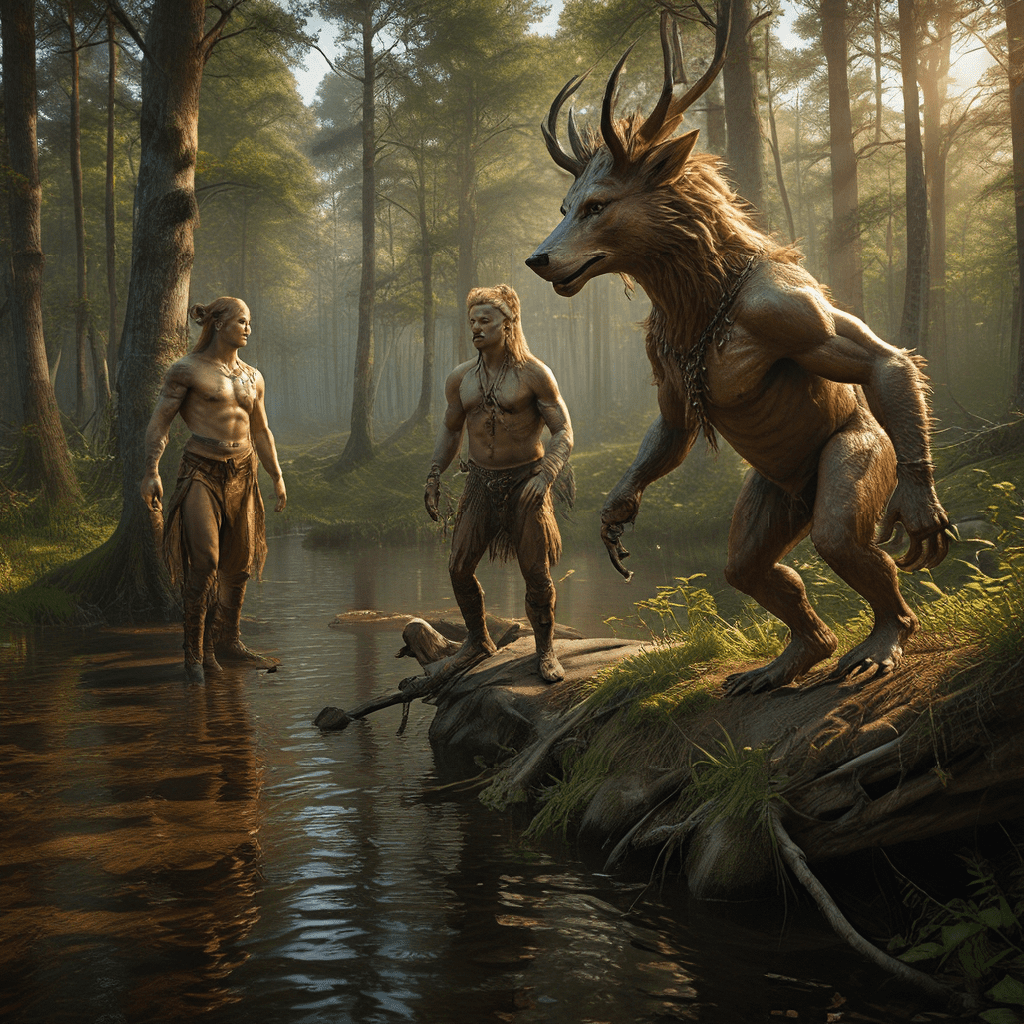The World of Baltic Folklore: A Realm of Mythical Creatures
Step into the enchanting world of Baltic folklore, a realm brimming with mythical creatures that have captivated imaginations for centuries. From the sun-drenched shores of the Baltic Sea to the depths of ancient forests, these fantastical beings weave their way through tales and legends, reflecting the unique beliefs and cultural heritage of the Baltic people.
Baltic folklore, encompassing the traditions of Latvia, Lithuania, and Estonia, is a rich tapestry of stories that offer a glimpse into the worldview of these ancient cultures. These myths and legends not only entertain but also serve as powerful reflections of the relationship between humans and the natural world.
A Tapestry of Beliefs: Exploring the Roots of Baltic Mythology
The roots of Baltic mythology lie deep in the heart of pagan beliefs, where nature held a profound spiritual significance. The Baltic people saw the world as a living entity, pulsating with divine forces and inhabited by a myriad of supernatural beings. The forests, rivers, lakes, and mountains were believed to be teeming with spirits, each with its own role in the cosmic order.
The creation myths, like the Latvian tale of the "World Egg," narrate how the world came into being from a primordial state. These myths underscore the importance of the Earth as a sacred entity, deserving of reverence and respect. The Baltic people saw themselves as integral parts of this interconnected web of life, and their folklore serves as a reminder of this intimate bond with nature.
The Guardians of the Forest: Spirits and Creatures of the Woods
The Baltic forests, with their dense groves and shadowy glades, were considered to be the domains of various spirits and creatures. The most prominent among them is the "Laumės," the female spirits of the forest who are known for their enchanting beauty and magical abilities.
Laumės are often depicted as benevolent guardians of nature, protecting the forests and their inhabitants. They are believed to have the power to heal, bestow fertility, and bring prosperity to those who respect the forest's sacredness. They also have a darker side, capable of inflicting harm on those who disregard their warnings or disrespect their domain.
Another noteworthy creature of the forest is the "Ragana," the witch. Raganas are often portrayed as powerful figures possessing magical abilities, although their intentions are not always benevolent. They are associated with the realm of the supernatural, capable of influencing weather, casting spells, and even transforming into animal forms. While some Raganas may utilize their powers for good, others are known to be mischievous or malevolent, causing harm to those who cross their path.
Water Spirits and Their Domain: From Lakes to Rivers
The waters of the Baltic Sea, lakes, and rivers are also home to a collection of fascinating creatures and spirits that hold a unique place in Baltic folklore. Among them is the "Ūdensvīrs," the water spirit often depicted as a humanoid form with a long beard and flowing hair.
Ūdensvīri are said to reside in the depths of bodies of water, their presence felt in the swirling currents and the mysterious depths. Sometimes benevolent, guiding lost travelers and fishermen to safety, they can also be mischievous and even dangerous, luring unsuspecting souls into the watery abyss.
The "Undīne," the water nymph, is another captivating figure in Baltic mythology. These beautiful and ethereal beings are said to inhabit lakes and streams, their voices echoing through the mists and their laughter resonating through the reeds. Undīnes often interact with humans, bestowing blessings upon those who respect their domain, but they can also be capricious, their moods shifting like the tides.
Creatures of the Hearth and Home: Protecting the Family
Baltic folklore is not merely confined to the forests and waters but extends into the realm of the home, where spirits and creatures play a crucial role in protecting families and ensuring well-being. The "Svečius," the house spirit, is a pivotal figure in these beliefs.
Svečius is believed to reside in the home, often taking the form of a small, unseen creature. This spirit is responsible for protecting the family from harm, ensuring their prosperity, and bringing good luck. However, Svecius's favor must be earned through respect for the home and its traditions. Neglecting household duties or disrespecting the spirit can invite misfortune and ill luck.
Another guardian of the home is the "Vaiņags," the spirit of the family's ancestors. Vaiņags is often represented as a benevolent spirit, watching over descendants and offering guidance and protection. Families often honor Vaiņags through rituals and offerings, ensuring the continued support of their ancestors.
A Legacy of Fear and Reverence: The Role of Mythical Creatures in Baltic Folklore
Baltic mythical creatures are not just fanciful beings; they play a crucial role in shaping the worldview and cultural identity of the Baltic people. These creatures embody both fear and reverence, reflecting a deep connection with the natural world and the importance of respecting its forces.
The stories about mythical creatures teach valuable lessons about the consequences of disrespecting nature, the importance of community, and the power of belief. For example, tales about the "Laumės" emphasize the need to protect the forests and show respect for their spirit. The stories about "Ūdensvīri" warn about the dangers of disrespecting water and its spirits. These tales serve as reminders that human actions have consequences, both in the physical and spiritual realms.
The fear associated with these creatures is often a healthy reminder of the potential dangers of the natural world. It encourages caution, respect, and a sense of humility in the face of the unknown. However, fear is often intertwined with a sense of reverence. Baltic people believed that these creatures possessed a power that could be harnessed for good, and they sought their favor through rituals and offerings.
The Power of Transformation: Shapeshifters and the Supernatural
One of the most captivating aspects of Baltic folklore is the presence of shapeshifters, beings who can transform their form at will. These creatures represent the fluidity and mystery of the supernatural world, often blurring the boundaries between the human and the divine.
One of the most famous shapeshifters in Baltic mythology is the "Vilkatis," the werewolf. The Vilkatis is often depicted as a human who transforms into a wolf, usually under the influence of a curse or magical spell. This creature embodies the primal instincts and power of the wild, reminding people of their connection to the animal kingdom.
Other shapeshifters include the "Raganas," who are known to transform into birds or other animals to travel unseen or to perform their magic. But shapeshifting is not limited to creatures of the forest and waters. Some humans were also believed to possess the ability to transform, often using this power for good or evil depending on their intentions.
Echoes of the Past: Tracing the Origins of Baltic Creatures
The roots of Baltic mythical creatures lie deep in ancient pagan beliefs, where nature was revered and seen as a source of both power and mystery. These creatures reflect a worldview that saw the world as populated by spirits and deities, each with their own role in the cosmic order.
Many Baltic creatures share similarities with creatures found in other Indo-European mythologies, suggesting common origins and shared beliefs. The "Laumės," for example, share similarities with the fairies of Celtic mythology and the nymphs of Greek mythology, suggesting a shared Indo-European origin for these nature spirits.
The Influence of Pagan Beliefs: Connecting with Nature and the Divine
Baltic folklore is deeply rooted in pagan beliefs, where nature held a profound spiritual significance. The Baltic people saw the world as a living entity, pulsating with divine forces and inhabited by a myriad of supernatural beings. The forests, rivers, lakes, and mountains were believed to be teeming with spirits, each with its own role in the cosmic order.
The Baltic people believed that these spirits and creatures could influence their lives, and they sought to appease them through rituals and offerings. This belief system highlighted the interconnectedness of all living things and the importance of respecting the natural world. The spirits of nature were not just creatures to be feared but were also sources of power and guidance.
Exploring the Modern Legacy: Mythical Creatures in Contemporary Baltic Culture
While Baltic folklore is deeply rooted in the past, it continues to exert a powerful influence on contemporary Baltic culture. Mythical creatures are often featured in art, literature, and music, reflecting a lasting fascination with these fascinating beings.
Baltic artists frequently incorporate mythical creatures into their works, creating captivating depictions of these creatures and their stories. Writers continue to weave tales inspired by Baltic folklore, bringing the stories of mythical creatures to new generations. Even in modern cities, the echoes of ancient beliefs can be felt in the names of streets, parks, and even businesses, reminding people of the enduring legacy of these fascinating creatures.
FAQ
Q: What are some of the most famous mythical creatures in Baltic folklore?
A: Some of the most well-known creatures include: Laumės (forest spirits), Ūdensvīri (water spirits), Raganas (witches), Vilkatis (werewolf), and Svecius (house spirit).
Q: Do these creatures only appear in stories, or were people believed to have encountered them in real life?
A: Baltic people believed that these creatures were real beings that existed in the world alongside humans. Stories were often based on encounters with or sightings of these creatures, and they were seen as a part of everyday life.
Q: How do these creatures reflect the beliefs of the Baltic people?
A: These creatures reflect the strong connection between the Baltic people and the natural world. They represent the power and mystery of nature, the importance of respecting its forces, and the need to live in harmony with the environment.
Q: What is the significance of shapeshifters in Baltic mythology?
A: Shapeshifters like the Vilkatis represent the fluidity and ambiguity of the supernatural world, blurring the lines between human and animal, and the physical and spiritual. They highlight the potential for transformation and the unpredictable nature of the unknown.
Q: Is Baltic mythology still relevant today?
A: Despite its roots in ancient beliefs, Baltic mythology remains a valuable part of contemporary Baltic culture. It continues to inspire artists, writers, and musicians, and it serves as a reminder of the enduring power of these fascinating stories.
Q: Where can I learn more about Baltic folklore?
A: There are many resources available to help learn more about Baltic folklore, including books, websites, and museums dedicated to preserving these rich traditions.




